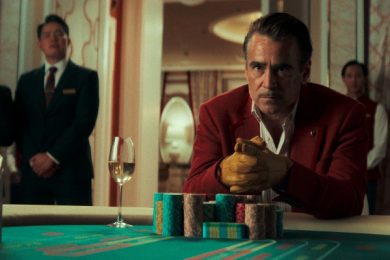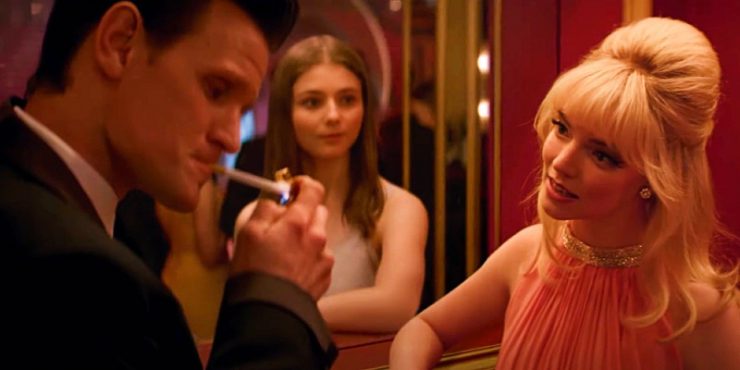The image of Swinging 1960s London is immortalized in films like Michael Antonioni’s Blow-Up and John Schlesinger’s Darling. In those films, and several others, high fashion and sexuality entangle with the sinister underbelly of vice and murder. Their darkness enhances their stylish levity, a heavy dose of stakes within an empty existence of bright colors and liberal drug use. This is the period that Edgar Wright is attempting to evoke in Last Night in Soho. Wright is no stranger to evoking past film styles. His Simon Pegg trilogy – Shaun of the Dead, Hot Fuzz, and The World’s End – were all humorous send-ups of specific genres (zombie film, police procedural, apocalypse spectacle), that were too jokey to be homage and too austere to be classified as spoof.
His films exist in a middle ground, both within and outside the constrains of the style he is attempting to evoke. It’s a tenuous balancing act, and one that he usually pulls off. Last Night in Soho – his worst, least funny film – does not continue that tradition. Working with themes of mental illness, eroticism, and murder, Wright alludes to Polanski’s haunting 1965 film Repulsion. That film is a blistering, hard-to-watch psycho-thriller in which Catherine Deneuve plays a troubled young woman who slides deep into insanity inside an apartment, fighting off nightmarish hallucinations and various men trying to take advantage of her fragility. Soho stars Thomasin McKenzie as Eloise, a fashion student who travels from Cornwall to London to attend college. “Ellie” is ready to start life on her own, but she brings demons – big and small – along with her.
Her mother killed herself when she was a young girl. Details are sparse but Ellie briefly explains that she was mentally unwell, a statement that takes on a stronger context when Ellie herself sees visions of her mother, only in mirrors. The visions (as Wright shows us) are vivid but without malice, and as Ellie decides to live on her own for the first time, it is with the knowledge that her mother’s presence will be one of comfort. But college life proves to be a difficult fit. Her roommate, Jocasta (Synnøve Karlsen), is an elitist already established in her social clique and dedicated to alienating the mousy Ellie. The social pressure of the dorm sends Ellie quickly away. She rents a small efficiency on the top floor of a building owned by the older Ms. Collins (Diana Rigg, in her final film role).
This is when the film starts to go haywire. At night she begins to have strikingly realistic dreams about the girl who used to live in her new apartment in the late 60’s. Sandie (Anya Taylor-Joy) is a wannabe singer and performer, who cozies up to a sleazy talent manager named Jack (Matt Smith) in the hopes of getting gigs. Sandie’s story becomes an almost film-within-the-film (a popular motif in 2021), and Ellie’s experience of it becomes more and more immersive. At times, it is as if she is physically experiencing Sadie’s existence. The secret life is seductive, but it soon turns dark as Sadie’s magical life becomes soured by disappointment. Jack’s promised fantasies of stardom turn into brutal realities of what it takes to make it in Swinging London. When the dreams become violent, Ellie’s grip of what is real and what is not becomes undone.
The same could be said for Wright’s grasp as to whether Ellie’s ghostly visions are an actual spectral possession or merely a consequence of Ellie’s own mental instability (her grandmother gravely fears that Ellie will meet the same fate as her mother). That mental illness is played exclusively as a plot point is far from the only tasteless aspect of Last Night in Soho, which struggles to connect its themes with its visual array of set pieces in a way that makes any functional sense. At times, Wright (who wrote the script with Krysty Wilson-Cairns) seems to be making points about misogyny and sexual violence, but his points are all rudimentary and essentially misogynistic in their own way (sexual shame pops up again and again).
The main theme seems to be a distrust of nostalgia, a be-careful-what-you-wish-for attitude toward romanticizing the past and what it represents. Ellie adores the 1960s. Her childhood bedroom has posters for Breakfast at Tiffany’s and Sweet Charity, her record player plays The Kinks and Cilla Black (Sadie’s hairstyle is another nod to Deneuve and 60’s stars of her ilk). Her naiveté about the era is the film’s main crux, and her visions of Sandie are the destruction of her innocence. Wright kinds of loses the plot on this as well. His undeniable talent for exciting, neon-colored sequences, and then later for horror movie jump scares, takes a bit of priority over paying off Ellie’s story. The script is propped up by inconsistencies and red herrings that get the film to two hours without leaving you with anything satisfactory.
Terrence Stamp plays a lecherous old man who patrons the Irish pub that Ellie eventually gets a job at. She fears that he is the arrogant, violent Jack in present day. His personality is provocative and dangerous. Stamp – a screen legend associated with exact era Soho romanticizes – is probably the only actor who understands the balance of sensuality and menace that Last Night in Soho needs. McKenzie and Taylor-Joy playing two sides of the same coin (modest and glamorous, blonde and brunette), feel lost in a sea of neurosis that Wright creates. Both young actors have proven their talent, and both are perhaps succeeding at creating the character they believe to be true, but they’re out of place, like most of Soho, and struggling to make something whole out of Wright’s admittedly handsome filmmaking.
Directed by Edgar Wright










